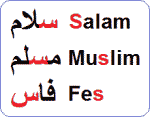
Arabic Alphabet (Script and Pronunciation)
Duration: 30 mins
This first lesson teaches the alphabet in Arabic. This includes the script and pronunciation. If you stay with me from start to finish, I promise you that you will learn a lot. I will try to give examples using both words and sound. That way it will be easy for you to see the letters when they are separate and when they are in a word. Going through the whole page should take about 30 min. Make sure to read the pronunciation and hear the audio as well. If you have any question about this course, please email me directly at Arabic Classes.
Alphabet
The alphabet is the building block of the Arabic language. Usually it is the first thing a person should start learning, because without it, you can neither read nor write. This means that the following 30 min are going to be the most important in your learning quest.
This video explains the Arabic alphabet. We recommend watching it before proceeding with the rest of this lesson.
Before starting, I would like to give you at least one reason why this lesson is very important. As a learner of Arabic, there are 2 ways of reading Arabic: 1) By reading the Arabic letters. 2) By reading the phonetic equivalent of the Arabic word by using Latin letters.
Even though Latin phonetics can provide a quick help, reading If you simply want to ask a question, please phnetics is not very reliable because Arabic does not have a standard phonetic equivalent for each word. For example the word "book" in Arabic is written phonetically as "ketaab", "kitaab", "kitab", "ketab" etc... On the other hand, if you decided to write it If you simply want to ask a question, please Arabic letters, then there is only one way of writing it. "كتاب". So I would recommend knowing how to read Arabic If you simply want to ask a question, please Arabic alphabet and not the phonetics.
The Arabic alphabet contains 28 letters and uses the abjad script and is written from right-to-left. However Arabic is sometimes written in Latin letters from left-to-right when a person does not have access to an Arabic keyboard or when a system does not support Arabic characters. This process is called romanization and lacks any standardized forms, but can be useful if the student does not have plants to go beyond the basic level.
Below is the Arabic alphabet in a table containing 4 columns (The sound of the Arabic letters, script, English equivalent, an example of the sound in English). Please note that whenever there is a *, that means there is no equivalent in English and that the best way to know how the letter sounds is to click on the sound button. Make sure you repeat each letter after you hear it.
Alphabet in Arabic
Questions?
If you have any questions, please contact me If you simply want to ask a question, please Arabic contact form on the header above.
The following is a table showing each letter of the alphabet based on its occurrence in a word. For example whether the letter occurs at the beginning of the word "initial", middle of the word, or at the end of the word "final". Look at the example below:

The letter "S" or "س" in Arabic is highlighted Red. Notice how it the "s" in Salam is different then the "s" in Fes? Do not let that scare you. The variation is simply for esthetic reasons. Also note that the change is not very dramatic. Check out the rest of the alphabet and see for yourself. Sometimes you will notice that there is no change at all.
Arabic Alphabet
Arabic Vowels
Imagine you decided one day to write in English by making each word as short as possible but you still want that word to be understood by others. So you decided to write the word "huwa" as "hw". But you got worried that others may not understand it. So you decided to add the missing "u" and "a" in tiny characters (image below). After a couple months, you got used to the fact that "hw" is pronounced "huwa" that you no longer need you to add the tiny letters anymore. So whenever you wrote letters "hw", you knew immediately it is pronounced as "huwa". That's how Arabic deals with vowels.

"Huwa" means "He" and "Hiya" means "She". If you look at the image above, you will see how Arabic used vowels (in red). They are usually omitted because most people already understand the meaning of words without the need for vowels. The only time vowels are used is to clear confusion or for teaching purposes.
This page will be updated soon to also include a table which will help you remember the Arabic alphabet by using mnemonic techniques for better retention.
Fun Facts
Language Quote ❝If you talk to a man in a language he understands, that goes to his head. If you talk to him in his own language, that goes to his heart.❞ ‒Nelson Mandela
Congratulations! You finished your first alphabet lesson in Arabic. Are you ready for the next lesson? We recommend Arabic Lesson 2. You can also simply click on one of the links below or go back to our Learn Arabic homepage.